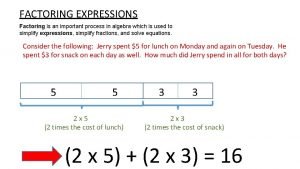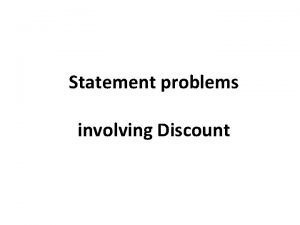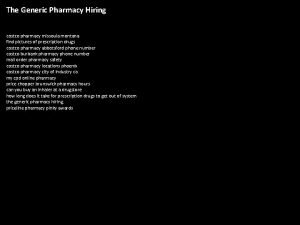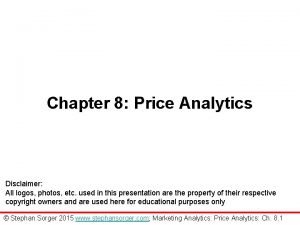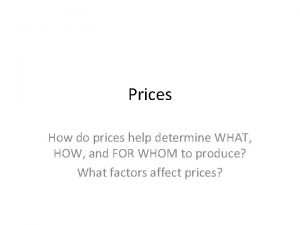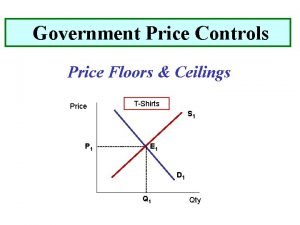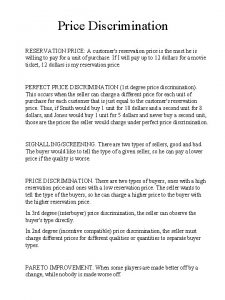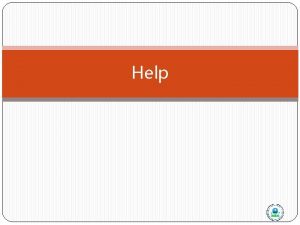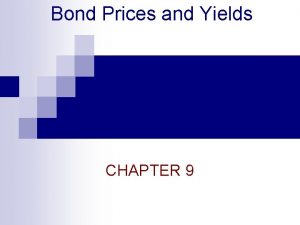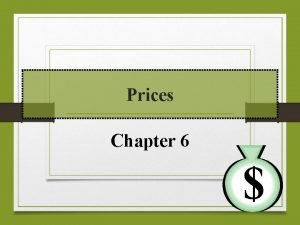Prices Price Important How do prices help us



















- Slides: 19

Prices

Price, Important? � How do prices help us make decisions? › Main Idea �Prices are decision-making tools that affect the behavior of individuals, businesses, markets, and industries. �Prices act as signals that tell people to buy more or less of a product, and producers to produce more or less of a product. �Prices help answer the questions WHAT, HOW, and FOR WHOM to produce because they are neutral, flexible, familiar, and efficient.

� Price › The monetary value of a product. � High Prices › Signal Producers to make more. � Low Prices › Signal Producers to make less

Price Advantages � Neutrality � Flexibility � Familiarity � Efficiency

Advantages � Neutrality › In a competitive market economy, prices are neutral because they favor neither the producer nor the consumer. Since prices are the result of competition between buyers and sellers, they represent compromises, or agreements, that both sides can live with.

Advantages � Flexibility › Prices in a market economy help provide flexibility. Events that cannot be predicted, such as natural disasters and war, can affect prices. For example, when Hurricane Sandy struck the northeast United States in October 2012, oyster gatherers in the Chesapeake Bay could not work for several days. This caused the price of oysters to temporarily increase as far away as Georgia. Buyers and sellers then reacted to the new level of prices and adjusted their consumption and production accordingly. This helped the system function smoothly again. The ability of the price system to absorb unexpected “shocks” is one of the strengths a market economy.

Advantages � Familiarity › Most people have known about prices all their lives. As a result, prices are familiar and easy to understand. There is no uncertainty or misunderstanding over a price—if something costs $1. 99, then we know exactly what we have to pay to get it. This allows people to make quick and easy decisions with a minimum of time and effort.

Advantages � Efficiency › Finally, prices have no administration or outside help. Competitive markets tend to help products find their own prices without outside help or interference. No administrators or office workers need to be hired, no committees formed, no laws passed, or other decisions made. Even when prices adjust from one level to another, the changes are usually so slow and steady that people hardly notice.

Rationing � Rationing: › a system in which government decides everyone’s “fair” share. � Main Ideas › Implementing a rationing system that everyone perceives as fair is almost impossible. › Rationing has high administrative expenses. › Rationing distorts market incentives and does not solve the basic problem of supply and demand. › Rationing systems can be abused and misused fairly easily.

Problems of Rationing � Perceived Fairness � Administrative Expense � Distorted Incentives � Abuse and Misuse

Problems � � Perceived Fairness The debate over fairness began immediately. People in small towns thought they should have more coupons than people in big cities, because big cities had better mass-transit systems. People with older cars thought they should have more coupons, because their cars were less fuel-efficient than newer ones. However, people with newer vehicles thought that this would punish them for having bought more expensive, fuel-efficient cars. Couples with several cars thought they should have more coupons because they had more cars. Couples with one car thought that would not be fair to them. As a result, making a distribution system that everyone thought would be fair seemed almost hopeless.

Problems � Administrative Expense › The administrative cost of rationing is another major issue. Someone would have to pay for the printing and distribution costs of the coupons, including the salaries of workers. Every community would also need “review boards” so that someone could listen to those who thought that they should have had more coupons. In 1974, nearly five billion gasoline ration coupons were printed just in case the government decided to go ahead with a rationing program. The plans, which were never carried out, were to ship the coupons to every post office in the country. Then everyone would have access to them after the “fairness” problem was resolved.

Problems � Distorted Incentives › Rationing programs are specifically designed to take the place of supply and demand. The one in 1974 that was designed to keep the cost of gasoline low for consumers would have had a negative effect on market incentives in three different ways: Energy companies would have been discouraged from producing more gasoline. Automobile companies would have had less incentive, or motivation, to produce more fuel-efficient vehicles. And consumers would have had less incentive to reduce unnecessary driving to save gasoline. None of these incentives solved the basic problem of too little supply and too much demand.

Problems � Abuse and Misuse › Finally, no matter how much care was taken, some coupons would have been stolen, sold, or counterfeited. The 1974 gasoline coupons had another unique problem. To make them difficult to counterfeit, or imitate, each carried a high-quality image of President Washington like the on a dollar bill. Unfortunately the likeness was so good that a coupon could also be used in a dollarchanging machine. This gave anyone with a coupon two options. They could use it for a gallon of gas, which cost about sixty cents, or they could use it in a coin changer to get four quarters. These problems were almost impossible to solve. It was mostly for these reasons that the 1974 gasoline rationing coupons were never issued and were later destroyed.

� What types of governments do you think are most likely to make allocations based on rationing? Why? › Totalitarian; those types of governments generally control purchasing decisions

Price v. Rationing � What are the differences between the price system and rationing? › Price system: people make their own purchasing decisions based on the prices of goods and services. Rationing system: government agency decides what and how many goods and services people will receive.

Price as a system � Preices are seen as the most efficient way to…. › Allocate resources

� Economists see prices as a system because: › It links all markets in the economy. �Read pg 158 -159 on how markets are linked to gas prices. › How do prices help allocate resources between markets? �Price increases in a certain market lower demand, which causes manufacturers to shift resources to more profitable markets.

 Ang price ceiling ay kilala rin sa katawagang bilang
Ang price ceiling ay kilala rin sa katawagang bilang My mother makes me chicken
My mother makes me chicken Im being oppressed
Im being oppressed Master asl unit 2 pdf answers
Master asl unit 2 pdf answers Helper chapter 1
Helper chapter 1 Education through self help is our motto
Education through self help is our motto Freesurfer troubleshooting
Freesurfer troubleshooting Factoring is an important process that helps us understand
Factoring is an important process that helps us understand From most important to least important in writing
From most important to least important in writing Least important to most important
Least important to most important From most important to least important in writing
From most important to least important in writing Disadvantages of hire purchase
Disadvantages of hire purchase Difference between reactive sourcing and strategic sourcing
Difference between reactive sourcing and strategic sourcing Price discovery and price determination
Price discovery and price determination Marked price-selling price=
Marked price-selling price= Costco cave creek and 101
Costco cave creek and 101 Always low prices
Always low prices Earl ingram ingram ready mix
Earl ingram ingram ready mix Fort wayne zoo prices
Fort wayne zoo prices Lower prices
Lower prices







